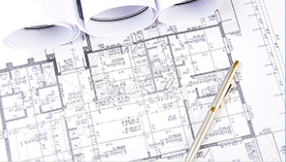New Home Ideas - House Building Ideas and Design Tips
OUR CHECKLIST TO FINDING YOUR HOUSE
PLAN AND BUILDING YOUR DREAM HOME:
Building your dream home is an exciting and rewarding experi-
ence. It does require a careful planning and good understanding
of the process. To help you get started, we have included this
overview as a typical home building checklist.

OUR CHECKLIST TO FINDING YOUR HOUSE
PLAN AND BUILDING YOUR DREAM HOME

Establishing a home building budget is essential for good planning and avoiding surprises. The components of pricing out your home will vary based upon the region of the country you live in, the size and type of house, specifics of your building lot, and the quality / selection of building materials. If you have yet to purchase a building lot, be sure to include that and the cost of any lot improvements required to start building in your budget.
Once you have established a budget, consider what style of house you would like. Would you prefer a one or two story home? Are you considering a slab foundation or a full basement? Such choices will have a direct impact on the construction cost regardless of the type of architectural style chosen. Next consider what type of architectural style you prefer. This may be driven by your personal preferences, by the region you live in, or both. Certain architectural styles will inevitably increase the construction cost of your home and should be accounted for in your budget. For example, ranch or one story home plans are usually rather simple in terms of their architecture as compared to many house plans in the classic Florida style with Mediterranean style or Spanish style architectural elements.
If you don’t already own a building lot for your home, you will need to find one. Depending on the area you live, there are a number of options to pursue to find a residential building lot. In suburban areas, developers often offer buildable lots for sale in home building communities. These lots are often all prepped for home construction in terms of cleared land, established utility hook-ups, and an often more streamlined permitting process. In other regions, classified ads are often the primary source to find home building lots. Finally, seeking out a broker or real estate agent to help you in your search for a home building lot can often make the process go more quickly although may also involve a fee.
With your budget and home style in mind, this is the most important part of the process. How many rooms and square footage do you want? What about the number of bedrooms and bathrooms? Will there be an attached garage and if so how many garage bays? You can take your specs to a house designer or architect who can then draw up a detailed set of floor plans for a substantial fee. Alternatively, you can search for your home and purchase pre-drawn floor plans at a significantly lower cost. If necessary, these house plans can then be modified to suit your own preferences by a local draftsman or even your home builder.
Take your house plans and talk to several contractors / home builders in your area. Based upon the house plans, your building lot and any personal preferences you may have, ask for each home builder to provide you with an estimate. Do your own homework on each of the contractors you have identified. Look for reviews online, check with the Better Business Bureau and any state licensing agencies. Get a list of houses the builder has constructed recently in your area and check them out to get a better idea of the home builder’s work. The lowest estimate can often not be the best option unless you have done a thorough background review. Remember, you will be working with this home builder for the next four to nine months so once you have identified your home builder, be sure to draft a comprehensive contract to avoid misunderstandings and to keep your house building on time and on budget.
Present your house plans, lot information and home builder’s estimate to the bank. Ideally, it is best to try and get pre-qualified for a loan earlier in the process to make sure your budget is reasonable and avoid any last minute surprises. There are a number of types of construction loan structures available depending on your area and the market so you may want to do additional research. Typically, you will receive a home construction loan that will be used to pay the builder in stages during the construction of your home. This loan will then be paid off with a residential mortgage once the house is approved for occupancy. You will also likely need to put in place construction insurance as part of the bank financing.
In most home building situations, you will be required by your local town or government to submit your lot information and house plans to local building officials for approval. This is to make sure your plans and lot information comply with local regulations. While many regions of the country follow national building codes, local regulations can vary depending on the region of the country. For example, houses built in earthquake-prone areas will be subject to much stricter regulations than you will find in most other regions. It is best to contact your local building official to determine key regulations and permit requirements that cover your building lot early in the process. As you get closer to starting home construction, your home builder can also help you navigate the permitting process.
Once your building lot has been cleared of unwanted trees, the land has been rough graded and temporary utilities established (you will need them during construction), actual home construction can begin. Depending on your chosen foundation, earth-moving equipment will excavate your foundation footings will be drilled and concrete will be poured.
With the foundation complete, the house framing can begin – and this is when the construction site starts to look like a house! The floors, walls, ceilings and roof are framed out first. Once completed, the windows and exterior doors are then installed followed by the exterior siding such as brick, siding or stucco. Work on the mechanical systems can then begin; these include HVAC (heating, ventilating and cooling) duct work, rough plumbing and rough electrical. These should be installed by licensed subcontractors. The roof should be completed after HVAC and plumbing have been roughed out but before electrical begins – some pipes will ventilate through the roof and you don’t want the electrical work be exposed to rain. Any insulation needed should be installed now.
Once all “behind the wall” systems are in place and any required inspections complete, drywall can be hung followed by cabinets, interior doors and trim. A first coat of paint should be applied to the walls and ceilings before any hardwood floors, vinyl floors or ceramic tile are installed. Any major appliances (refrigerator, washer, dryer) should then be set in place. The mechanical systems should be finished – electrical outlets, plumbing fixtures, heating/cooling registers – and checked to make sure they are in proper working order. Final paint and wood floor finished are now done.
Once the heavy trucks are gone, you may want your builder to complete any agreed-upon walks, drives or patios. You house should now be in move-in condition!
In addition to reviews at each phase of the construction process, you will want to do a final inspection of the house with your builder to review everything in detail. Before you can move in, your local building official will conduct a final inspection to ensure the work was done “to code.” If so, he will issue a Certificate of Occupancy (also called a “CO”).
You can now move into your new house! But before the moving trucks arrive, it is best if your budget allows it, to do some basic decorating work. Paint or wallpaper the rooms to your desired taste – it is far more difficult and time consuming to do so once there is furniture in the room! Select window treatments and have them installed. If there are any large area rugs or pieces of furniture you want to purchase, do so now and have them delivered before the moving trucks arrive. Once you’ve moved in you are ready to turn your new house into your new home.
- Building Codes and Permits
- How to Read Blueprints?
- Choosing the Right House Plans
- Insurance and Legal Assitance
- Cost-to-Build
- FAQ
- Knowledge Base Articles
- Financing
- Understanding Copyright
- Find-A-Builder
- What's included in a set of house plans?
- Glossary of Terms
- Why pre-drawn house plans?
- Building Materials
- Turn Any Plan into Your Dream Home
- Architectural Styles/Architecture
- Home Building
- Home Design & Floor Plans
- Home Improvement & Remodeling
- FAQ
- New Home Resources
- Glossary of Terms
- Understanding Blueprints
- Understanding Copyright
- What is included in a set of house plans?
- Why pre-drawn house plans?
- Turn Any Plan into Your Dream Home
- Choosing a Floor Plan Resources
- Home Building Process Resources
- Top Houses Around the World to Visit





